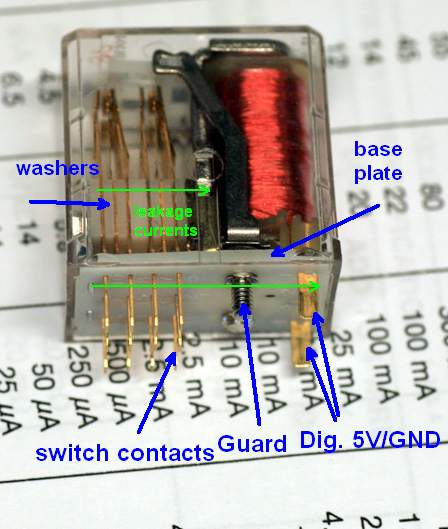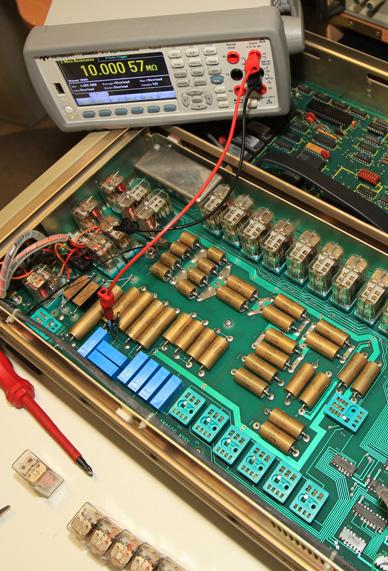I calibrated my 5450A again, after one year, see column G
And again, the verification of 10M, 19M and 100M were way off, compared to the verification by 3458A, column I.

I opened the instrument, and measured these high Ohm values directly inside the unit, at the resistors, as indicated in the picture. The 5450A is set to OPEN, which de-energizes all relays.

From the measured values, "direct", in column K and M, you can see, that now all the high-Ohm readings were very well matching the before calibrated values.
As soon as I engaged the appropriate range, the readings dropped to the faulty values, between 50 to 300pm low. That's displayed in the picture above.
Therefore, there has to exist a leakage path inside the 5450A.
I de-soldered the high output/sense PTFE cables, as indicated here:

The measurement of the 100M stabilized much faster, but was faulty as before.
When unsoldering the cable to relay K30, the correct reading applied. K30 is open for the 100M Ohm range.
So I disassembled the K30 relay socket, and measured its leakage by applying 50V between two open contacts and monitoring the current, being <1pA. Therefore, the socket should have > 5 * 10^13 Ohm. In parallel to 100MOhm, that will create an error of a few ppm at most.
Anyhow, I cleaned the socket and its top and bottom area of the PCB with methyl alcohol. This did not yet cure the error.
So I investigated on relay K30.
Between isolated pins, @ 50V, I measured leakage currents on the order of 20..40pA, i.e. between two open relay contacts, between switch contact and guard (relay metal body), and between switch contact and coil contacts.
That gives leak resistors of about 10^12 Ohm each, giving an error for the 100MOhm resistor of several 100pm, as these paths add up.
It can also be observed, that the 5V digital supply may even source leakage currents into the network.

At a closer look on relay K30, you may see the base plate and the isolation washers, which are made from some plastic, which I assume not to be PTFE.
This plastic will give rise to the leakage currents across all the contacts, as indicated by the green arrows. I assume, that this plastic material contains filler / softening agent, which has outgassed or diffused after 30 years, and creates this leakage. Maybe the plastic material itself deteriorates, and the cracked products are conducting.
I disassembled the relay , removed the coil, and washed the contacts and base plate using benzine and methyl alcohol. This gave no improvement, the leakage currents remained the same.
The leakage of all mechanical relay K15..K20, K30 and K31 may affect the high Ohm readings.
If I pull these out, and engage the high Ohm ranges, the reading now will not drop any more.

Everybody can measure this summed leakage by applying 50V between case ground and guard. I observed about 450pA leakage current, so about 10^11 Ohm isolation only between analog and digital, and the resistor chain.. that's an order of 1000ppm error related to the 100M resistor.
The explanation, why it's possible to calibrate correctly, is indicated in the schematics. You see, that the 50V test voltage across 100M is divided to about 5V. The ratio between both voltage measurements gives the calibration ratio from 10M to 100M. The crucial leakage current does not affect the 100M resistor in this volt - measurement mode, but will definitely decrease its value during any normal resistance measurement.
There's only a leakage in parallel to the 10M resistor, which affects this ratio measurement, but an order of magnitude smaller, i.e. on the order of about 10ppm.

This error description is independent from brand of DMM and from measurement voltage, 10V or 100V, or else. So, even the highly prestigious 8508A will show the exact same error, in normal or in high voltage resistance mode.
So I conclude, that the HP instruments measure high Ohm very well, inside specification, or better.
The 5450A itself causes this fault in the high Ohm ranges. The same observations have been made for the instruments of eevblog (#544, 33:52 .. 34:10 min), PeLuLe, quarks, and mine, and maybe also by zlymex.
The Fluke PWW resistors are really great, but these mechanical relays suck.
Therefore, this is a systematic error after many years.
These relays may be un-obtainium as new.
Old stock is very expensive, I've seen about 80$ for 1 EA, but they will have definitely the same problem.
TYCO still offers these standard R10 relays, but isolation is specified the same, 10^11 Ohm, which is 3 orders of magnitude short.
In retrospect, the Fluke engineers faced the problem that these mechanical relays should isolate to 10^14 Ohm, but also would be able to carry up to 500mA of current. In this design, it was not possible to solve this contradiction. Maybe a look into the similar 5720A design might reveal, how it can be done better.
Or these newer instruments will face the same problem, after more than 10 years time.
To solve this problem in the 5450A, I think over separating higher and lower ranges by interrupting the path between the high ohm reed relays and the lower ohm mechanical relays, and connecting the high ohm ranges (1M ..100M) to the front jacks, and the lower Ohm ranges (1 Ohm .. 190 kOhm) to the rear.
Maybe later I'll find some really highly isolated reed relays, 5V coil and 100mA carriage current, to replace the failing relays.
Some final remarks about the uncertainty of the calibration process.
I used the 5442A as a DCV source and the 3458A for the ratio measurements.
In the standard procedure, which follows the manual, the measured voltages and offsets were recorded in the calculation Excel-sheet, starting from my external 10k standard. The fields marked in green then display the calibrated value, which is consecutively used for the next upper/lower range.

As the 3458A may create additional leakage currents for the high Ohm ranges, I used an additional procedure, with two measurements for each resistance value, to cancel these DVM currents.
That gives very similar readings as the the standard process.

I also processed this latter method directly inside the open instrument, which also gave consistent results to the calibration from outside.
So I conclude, that the normal calibration process is really not much effected by the relays leakage.
Frank